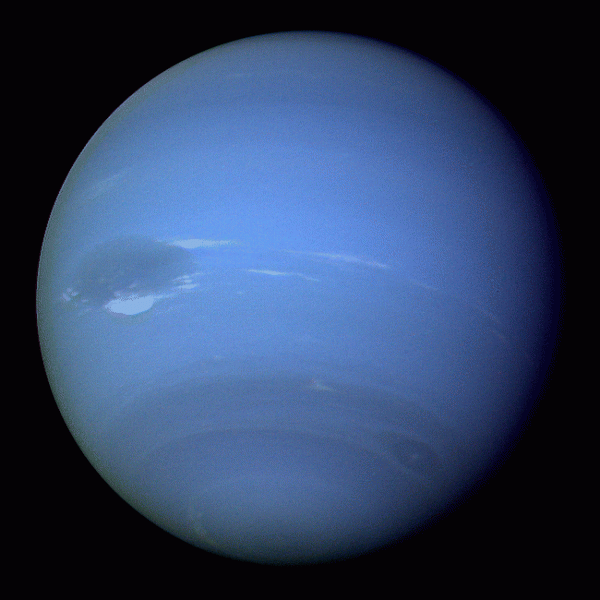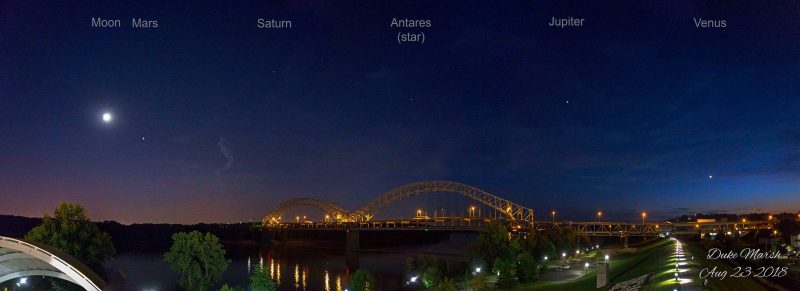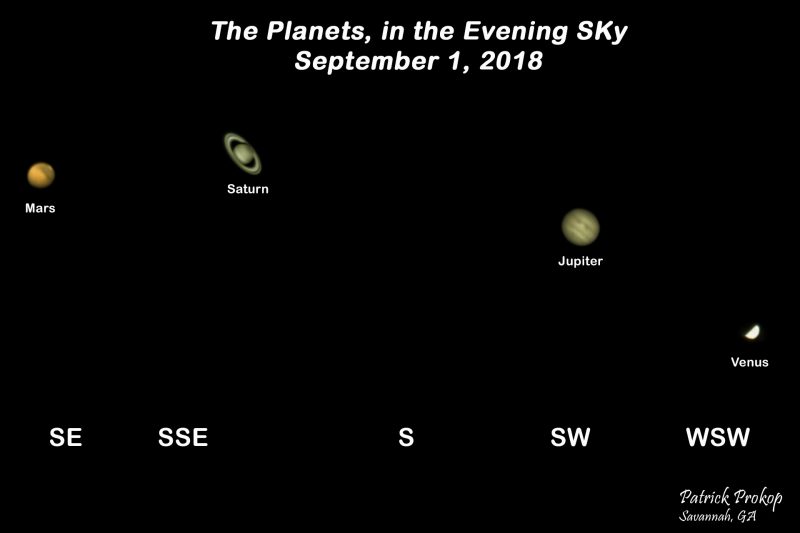
On September 6, Earth and Neptune are closest for 2018. One day later, on September 7, Neptune reaches opposition, when it is 180 degrees from the sun in our sky. In other words, on September 7, Earth passes more or less between Neptune and the sun now, as we do every year in our yearly orbit.
Why isn’t Neptune closest on the day we pass between it and the sun?
The answer relates to Neptune itself, and its long orbit around our local star. Neptune takes 166.6 Earth-years to complete a single orbit. Right now, this planet is moving toward its aphelion, or farthest point from the sun, on September 3, 2042. With each passing day on Earth, Neptune is slightly farther from the sun than it was the day before. It’s farther from the sun – and therefore farther from us on the day we pass between it and the sun – than on the previous day.
So Neptune is closest September 6. And by closest, we don’t mean close. Neptune, the 8th planet outward from the sun, lodges in the outskirts of our solar system. Its current distance is about approximately 2,689,502,000 miles (4,328,336,000 km).
Opposition is a special event. When any planet outside of Earth’s orbit is at or near opposition, Earth comes closest to that planet for the year, and that planet, in turn, shines most brightly in our sky. Even at opposition, however, Neptune, the 8th planet, is not bright by human standards. In fact, Neptune is the only major solar system planet that’s absolutely not visible to the unaided eye. This world is about five times fainter than the dimmest star that you can see on an inky black night. You’ll need binoculars (at least) and a detailed sky chart to see Neptune in front of the constellation Aquarius.
Here’s a chart showing Neptune for the May 2018 to March 2019 observing season
Here’s another detailed sky chart showing Neptune

In 1989, NASA’s Voyager 2 became the first spacecraft to observe Neptune. More about this image and more photos from Voyager 1’s flyby.
Because we’re more or less between Netune and the sun around now, Neptune is rising in the east around the time of sunset, climbing highest up for the night around midnight and setting in the west around sunrise. As viewed from Earth now, this world is in front of the constellation Aquarius the Water Carrier.
In 2018, the moon turns new only two days after Neptune reaches opposition. That means dark nights to accompany this year’s Neptune opposition.
Many sky watchers will go to dark country skies to see Neptune now. They’ll find the faint star Lambda Aquarii and Phi Aquarii with the unaided eye and then star-hop to Neptune. See sky chart below.
Even with binoculars, however, Neptune will appear only as a faint star.

Sky chart of the constellation Aquarius via IAU. Seek for Neptune in between Lamba and Phi Aquarii.
We know it’s unlikely you’ll see Neptune unless you have optical aid and a detailed star chart.
But there are four bright planets in the September 2018 sky. Look for Venus and Jupiter low in the west after sunset and for Venus, Mercury and Mars in the east before sunrise. Saturn is found in the southern sky at nightfall (or as seen from the Southern Hemisphere: high overhead).
Consolation prize? Maybe! But a really good one!
Read more: September guide to the bright planets

View larger. | Our friend Duke Marsh wrote on August 23, 2018: “Four of the five bright planets joined the moon for a lovely sight above the riverfront in New Albany, Indiana, Thursday evening. Each planet can be see directly below its name at the top. Looks best viewed full-screen on a computer monitor or large tablet.” These worlds will continue to light up the sky at nightfall throughout September 2018. Thanks, Duke!

View larger. | Patrick Prokop wrote: “This is a ‘mock-up’ of the planets’ views and positions. They don’t look like this in the sky, but, basically, these are those bright jewels in the evening sky in early September. I took all these through my telescope on the evening of September 1, 2018, from my backyard and then made this composite.” Thank you, Patrick!
Bottom line: We’re closest to Neptune for 2018 on September 6. Neptune’s opposition – when it’s 180 degrees from the sun on the sky’s dome – is one day later, on September 7. You need optical aid to spot it. Links to charts here.
from EarthSky https://ift.tt/2cesTUU

On September 6, Earth and Neptune are closest for 2018. One day later, on September 7, Neptune reaches opposition, when it is 180 degrees from the sun in our sky. In other words, on September 7, Earth passes more or less between Neptune and the sun now, as we do every year in our yearly orbit.
Why isn’t Neptune closest on the day we pass between it and the sun?
The answer relates to Neptune itself, and its long orbit around our local star. Neptune takes 166.6 Earth-years to complete a single orbit. Right now, this planet is moving toward its aphelion, or farthest point from the sun, on September 3, 2042. With each passing day on Earth, Neptune is slightly farther from the sun than it was the day before. It’s farther from the sun – and therefore farther from us on the day we pass between it and the sun – than on the previous day.
So Neptune is closest September 6. And by closest, we don’t mean close. Neptune, the 8th planet outward from the sun, lodges in the outskirts of our solar system. Its current distance is about approximately 2,689,502,000 miles (4,328,336,000 km).
Opposition is a special event. When any planet outside of Earth’s orbit is at or near opposition, Earth comes closest to that planet for the year, and that planet, in turn, shines most brightly in our sky. Even at opposition, however, Neptune, the 8th planet, is not bright by human standards. In fact, Neptune is the only major solar system planet that’s absolutely not visible to the unaided eye. This world is about five times fainter than the dimmest star that you can see on an inky black night. You’ll need binoculars (at least) and a detailed sky chart to see Neptune in front of the constellation Aquarius.
Here’s a chart showing Neptune for the May 2018 to March 2019 observing season
Here’s another detailed sky chart showing Neptune

In 1989, NASA’s Voyager 2 became the first spacecraft to observe Neptune. More about this image and more photos from Voyager 1’s flyby.
Because we’re more or less between Netune and the sun around now, Neptune is rising in the east around the time of sunset, climbing highest up for the night around midnight and setting in the west around sunrise. As viewed from Earth now, this world is in front of the constellation Aquarius the Water Carrier.
In 2018, the moon turns new only two days after Neptune reaches opposition. That means dark nights to accompany this year’s Neptune opposition.
Many sky watchers will go to dark country skies to see Neptune now. They’ll find the faint star Lambda Aquarii and Phi Aquarii with the unaided eye and then star-hop to Neptune. See sky chart below.
Even with binoculars, however, Neptune will appear only as a faint star.

Sky chart of the constellation Aquarius via IAU. Seek for Neptune in between Lamba and Phi Aquarii.
We know it’s unlikely you’ll see Neptune unless you have optical aid and a detailed star chart.
But there are four bright planets in the September 2018 sky. Look for Venus and Jupiter low in the west after sunset and for Venus, Mercury and Mars in the east before sunrise. Saturn is found in the southern sky at nightfall (or as seen from the Southern Hemisphere: high overhead).
Consolation prize? Maybe! But a really good one!
Read more: September guide to the bright planets

View larger. | Our friend Duke Marsh wrote on August 23, 2018: “Four of the five bright planets joined the moon for a lovely sight above the riverfront in New Albany, Indiana, Thursday evening. Each planet can be see directly below its name at the top. Looks best viewed full-screen on a computer monitor or large tablet.” These worlds will continue to light up the sky at nightfall throughout September 2018. Thanks, Duke!

View larger. | Patrick Prokop wrote: “This is a ‘mock-up’ of the planets’ views and positions. They don’t look like this in the sky, but, basically, these are those bright jewels in the evening sky in early September. I took all these through my telescope on the evening of September 1, 2018, from my backyard and then made this composite.” Thank you, Patrick!
Bottom line: We’re closest to Neptune for 2018 on September 6. Neptune’s opposition – when it’s 180 degrees from the sun on the sky’s dome – is one day later, on September 7. You need optical aid to spot it. Links to charts here.
from EarthSky https://ift.tt/2cesTUU

Aucun commentaire:
Enregistrer un commentaire